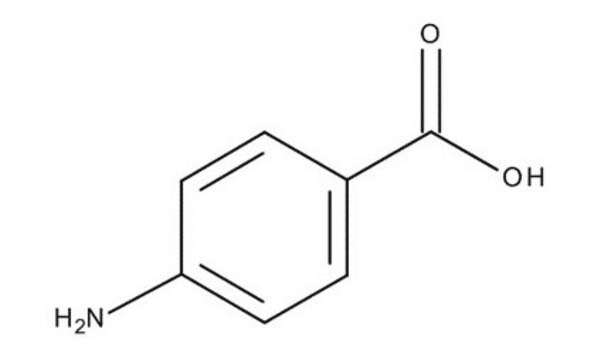8.21762
2,5-Di-tert-butylhydroquinone
for synthesis
Sinónimos:
2,5-Di-tert-butylhydroquinone
About This Item
Productos recomendados
Nivel de calidad
Análisis
≥98.0% (HPLC)
formulario
powder
temp. de autoignición
420 °C
mp
212-218 °C
temp. de almacenamiento
2-30°C
InChI
1S/C14H22O2/c1-13(2,3)9-7-12(16)10(8-11(9)15)14(4,5)6/h7-8,15-16H,1-6H3
Clave InChI
JZODKRWQWUWGCD-UHFFFAOYSA-N
Aplicación
- Food Contact Material Study: Investigated the occurrence and application areas of 2,5-di-tert-butylhydroquinone in food contact materials, highlighting its use and safety implications (Pedersen & Cederberg, 2014).
- Antibacterial and Anti-Biofilm Properties: Explored the potential use of DBHQ as an antibacterial and anti-biofilm agent against Staphylococcus aureus, suggesting new applications in medical and healthcare fields (Kim et al., 2022).
- Cognitive Performance and Metabolomics: Investigated serum and CSF metabolites, including DBHQ, in stroke-free patients, offering insights into vascular risk factors and cognitive performance, relevant for neurological drug development (Peng et al., 2020).
- Cellular Mechanism Study: Assessed the role of DBHQ in Ca2+ handling in cellular models, which could be critical for understanding cellular mechanisms in drug discovery and development (Liu et al., 2015).
- Review on Food Additives: A narrative review highlighting the excessive use of DBHQ in food products and its potential health impacts, emphasizing the need for accurate monitoring and regulatory review (Khezerlou et al., 2022).
Nota de análisis
Melting range (lower value): ≥ 212 °C
Melting range (upper value): ≤ 218 °C
Identity (IR): passes test
Palabra de señalización
Danger
Frases de peligro
Consejos de prudencia
Clasificaciones de peligro
Acute Tox. 3 Oral - Aquatic Acute 1 - Aquatic Chronic 1 - Skin Sens. 1 - STOT SE 3
Órganos de actuación
Respiratory system
Código de clase de almacenamiento
6.1C - Combustible, acute toxic Cat.3 / toxic compounds or compounds which causing chronic effects
Clase de riesgo para el agua (WGK)
WGK 3
Punto de inflamabilidad (°F)
Not applicable
Punto de inflamabilidad (°C)
Not applicable
Certificados de análisis (COA)
Busque Certificados de análisis (COA) introduciendo el número de lote del producto. Los números de lote se encuentran en la etiqueta del producto después de las palabras «Lot» o «Batch»
¿Ya tiene este producto?
Encuentre la documentación para los productos que ha comprado recientemente en la Biblioteca de documentos.
Nuestro equipo de científicos tiene experiencia en todas las áreas de investigación: Ciencias de la vida, Ciencia de los materiales, Síntesis química, Cromatografía, Analítica y muchas otras.
Póngase en contacto con el Servicio técnico









